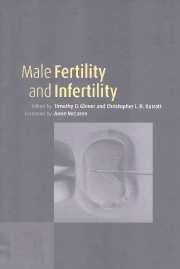Book contents
- Frontmatter
- Contents
- List of contributors
- Foreword by Anne McLaren, FRS
- Preface
- Acknowledgements
- Part 1 Biological perspectives
- Part 2 Implications of the new technologies
- 8 ICSI: the revolution and the portents
- 9 The genetic basis of male infertility
- 10 The treatment of azoospermia with surgery and ICSI
- 11 The challenge of asthenozoospermia
- 12 Molecular techniques for the diagnosis of inherited disorders and male reproductive malfunction
- 13 Gazing into the crystal ball: future diagnosis and management in andrology
- Index
9 - The genetic basis of male infertility
from Part 2 - Implications of the new technologies
Published online by Cambridge University Press: 09 August 2009
- Frontmatter
- Contents
- List of contributors
- Foreword by Anne McLaren, FRS
- Preface
- Acknowledgements
- Part 1 Biological perspectives
- Part 2 Implications of the new technologies
- 8 ICSI: the revolution and the portents
- 9 The genetic basis of male infertility
- 10 The treatment of azoospermia with surgery and ICSI
- 11 The challenge of asthenozoospermia
- 12 Molecular techniques for the diagnosis of inherited disorders and male reproductive malfunction
- 13 Gazing into the crystal ball: future diagnosis and management in andrology
- Index
Summary
Background information
It is estimated that about 30–40% of couples seeking fertility treatments are diagnosed with male factor infertility. The identification and classification of male infertility still relies on the results of the semen analysis, obtained on at least two separate occasions, and reported according to standard reference values set out by the World Health Organization (1992). Infertile males can be affected by azoospermia, oligozoospermia, asthenozoospermia, teratozoospermia or by any combination of any of these. Once a man is diagnosed as infertile or subfertile, he is usually referred to a reproductive specialist (andrologist or urologist) for evaluation. Today, even the most comprehensive work-up (which includes a detailed history and physical examination, hormonal and immunological assays, ultrasound or Doppler studies and genetic testing) may fail to detect the aetiology responsible for the reproductive disorder in about 60% of the cases. Lately, however, advances in molecular biology and molecular genetics are improving our understanding of many forms of male infertility previously classified as idiopathic. These discoveries are important for many reasons. First, with the use of assisted-reproductive technologies, in vitro fertilization (IVF) and intracytoplasmic sperm injection (ICSI), it is possible to offer reproductive hope to men once considered to be irreversibly sterile; however, in these instances, if genetic anomalies (mendelian and chromosomal disorders) are the cause of their infertility, then there is an increased risk of transmitting the genetic defects to future generations.
- Type
- Chapter
- Information
- Male Fertility and Infertility , pp. 162 - 179Publisher: Cambridge University PressPrint publication year: 1999



